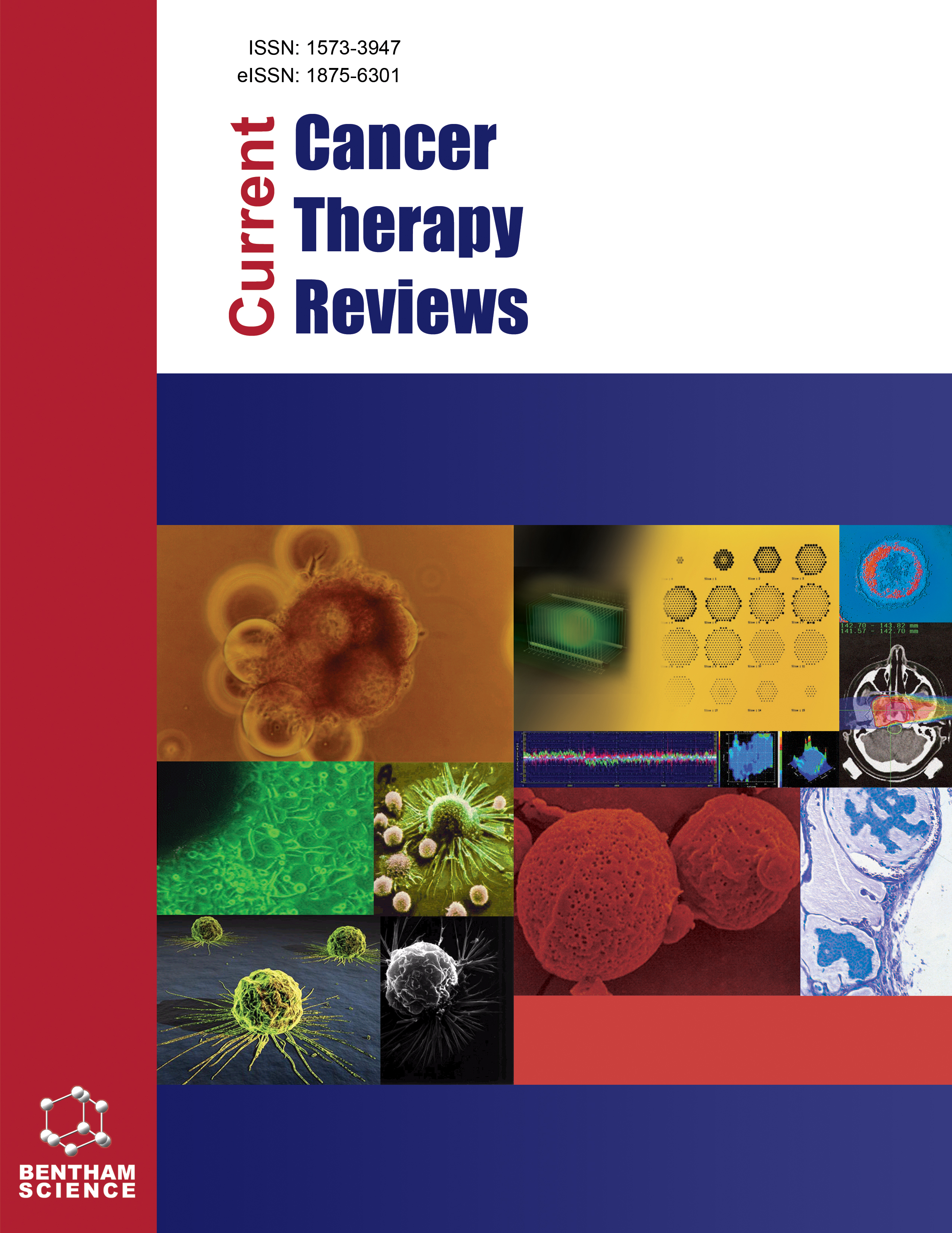- Home
- A-Z Publications
- Current Cancer Therapy Reviews
- Previous Issues
- Volume 8, Issue 3, 2012
Current Cancer Therapy Reviews - Volume 8, Issue 3, 2012
Volume 8, Issue 3, 2012
-
-
Histopathology of Ductal Carcinoma in Situ (DCIS) of the Breast
More LessBy Geza AcsDuctal carcinoma in situ (DCIS) is a heterogeneous entity, with a wide range of histological appearances including different architectural growth patterns, different nuclear morphology ranging from minimal to severe nuclear atypia, and the presence or absence of necrosis and calcification. Diagnostic criteria for DCIS depend on the degree of cytologic atypia, but in general include cytonuclear and architectural features, clon Read More
-
-
-
Imaging Intraductal Carcinoma
More LessIntraductal carcinoma (DCIS) was once an uncommon disease. Today, DCIS represents 20-30% of breast cancers that are diagnosed. Mammography has been the gold standard in detecting DCIS, however recent evidence demonstrates that magnetic resonance imaging (MRI) may be superior to mammography in detecting DCIS. In addition, MRI may be able to detect high grade, mammographically occult DCIS that Read More
-
-
-
Can We Identify a Subset of Patients with DCIS that can be Treated by Wide Excision Alone?
More LessAuthors: Carla S. Fisher, Gary M. Freedman and Julia TchouDuctal carcinoma in situ (DCIS) represents the earliest stage of breast cancer and accounts for approximately 20% of new breast cancer diagnoses. Mastectomy was the surgical treatment of choice prior to seminal data from several randomized control trials which provided evidence supporting the efficacy of breast conservation surgery (BCS) in DCIS. Controversy, however, persists regarding all patients with DCIS req Read More
-
-
-
Ductal Carcinoma In Situ: Clinical Trials Update and Resolving Controversies
More LessAuthors: Robert E. Roses and Henry M. KuererThe diagnosis of ductal carcinoma in situ (DCIS) has increased dramatically following the widespread adoption of screening mammography. DCIS has a favorable prognosis overall, but is associated with an increased risk of invasive breast cancer (IBC) and occasionally, with poor outcomes. The goal of the multidisciplinary treatment of DCIS is to prevent the development of invasive disease. The identification of patients at elevat Read More
-
-
-
High Survivin Expression in Ductal Carcinoma In Situ (DCIS): A Potential Therapeutic Target
More LessIntroduction: Survivin, a member of the Inhibitor of Apoptosis Proteins (IAP), is involved in cell proliferation, apoptosis suppression, and angiogenesis. Survivin is highly expressed in many cancers and its expression is often correlated with more aggressive disease and worse outcomes. Our goal was to characterize survivin expression in ductal carcinoma in situ (DCIS) with a specific interest in correlation to his Read More
-
-
-
Molecular Pathology and Molecular Markers of Ductal Carcinoma in-situ
More LessAuthors: Brynn Wolff and Shuko HaradaThe incidence of ductal carcinoma in-situ (DCIS) is increasing significantly. DCIS has been demonstrated to arise from terminal duct-lobular units and it is generally accepted that DCIS is a precursor lesion to the majority of invasive ductal carcinoma. DCIS is a highly heterogeneous lesion with variable morphology, clinical presentation and behavior, however, the exact molecular biology of DCIS is not yet resolved. Commonly us Read More
-
-
-
Recent Developments in Targeted Therapies of the RAF-MEK and PI3KAKT Pathways in Cancer Treatment
More LessAuthors: Lobke G.M. Cremers and Johannes BoonstraThe RAF-MEK and PI3K-AKT pathways are both frequently deregulated in cancer, and often play a critical role in oncogenesis. In the previous years, major progress has been made in the development of targeted drugs against signaling kinases which are involved in carcinogenesis. Currently, targeted drugs against RAF, MEK, PI3K and AKT (among several others) have entered clinical investigation. Here we describe tumor cau Read More
-
-
-
Sinonasal Carcinoma: Updated Phenotypic and Molecular Characterization
More LessAuthors: Diana Bell and Ehab Y. HannaThe most commonly encountered carcinoma of the sinonasal tract is the keratinizing/ non-keratinizing squamous cell carcinoma. However, this complex anatomic location may represent the site of other epithelial malignant neoplasms of varying histogenesis. These tumors are clinically aggressive and often fatal; historically, treatment outcomes have been poor. Differentiating these tumor types may have clinical impact Read More
-
-
-
Cyclin Dependent Kinase as Significant Target for Cancer Treatment
More LessAuthors: Sanjeev K. Singh, Sunil K. Tripathi, Nigus Dessalew and Poonam SinghCyclin Dependent Kinase (CDKs) regulates cell cycle commitment and DNA synthesis. Cell division in mammalian cells is driven by protein kinase that regulates progression through the various phases of cell cycle. The activity of cyclins and their associated CDKs are frequently deranged in human cancers. For this reason, Cyclin-CDK complexes have been considered as very promising therapeutic targets in human malignan Read More
-
Volumes & issues
-
Volume 21 (2025)
-
Volume 20 (2024)
-
Volume 19 (2023)
-
Volume 18 (2022)
-
Volume 17 (2021)
-
Volume 16 (2020)
-
Volume 15 (2019)
-
Volume 14 (2018)
-
Volume 13 (2017)
-
Volume 12 (2016)
-
Volume 11 (2015)
-
Volume 10 (2014)
-
Volume 9 (2013)
-
Volume 8 (2012)
-
Volume 7 (2011)
-
Volume 6 (2010)
-
Volume 5 (2009)
-
Volume 4 (2008)
-
Volume 3 (2007)
-
Volume 2 (2006)
-
Volume 1 (2005)
Most Read This Month
Article
content/journals/cctr
Journal
10
5
false
en


